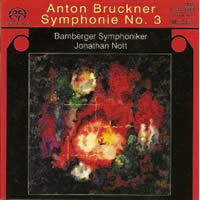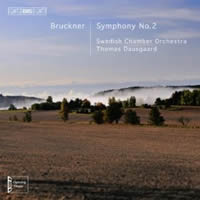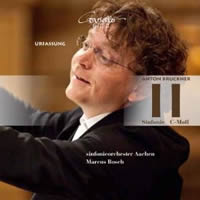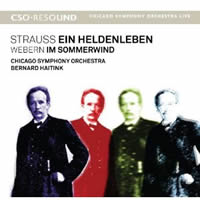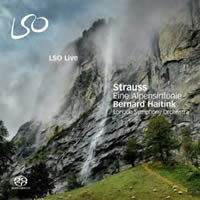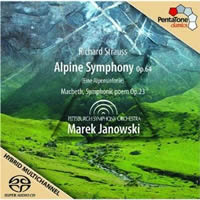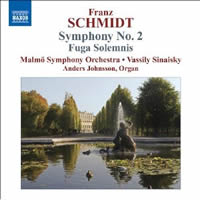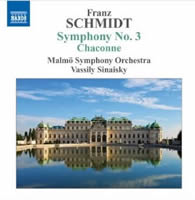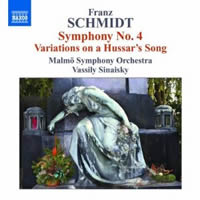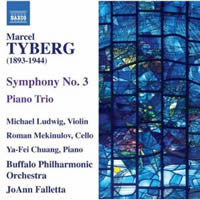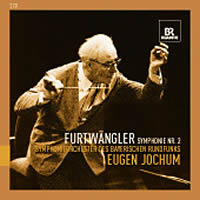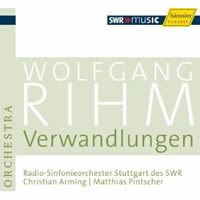Mostly Symphonies 17.
|
Grant Chu Covell [April 2011.]
Anton BRUCKNER: Symphony No. 3 (orig. 1873 vers.). Bamberger Symphoniker, Jonathan Nott (cond.). Tudor 7133 (1 SACD) (http://www.tudor.ch/). Distributed in the US by Naxos (http://www.naxos.com/). Other Thirds — in any version — made little impression until now. But then again, the Wagner nods pass unnoticed. Nott’s handling is liquid and vigorous. The Adagio’s rolling sweep prefers Romantic lushness over strict timekeeping, a characteristic effectively maintained in the Scherzo.
Anton BRUCKNER: Symphony No. 2 (1877 vers.). Swedish Chamber Orchestra, Thomas Dausgaard (cond.). BIS SACD 1829 (1 SACD) (http://www.bis.se/). Distributed in the US by Qualiton (http://www.qualiton.com/). Anton BRUCKNER: Symphony No. 2 (1872 vers.). Sinfonieorchester Aachen, Marcus Bosch (cond.). Coviello Classics COV 31015 (1 SACD) (http://www.covielloclassics.de/). Distributed in the US by Qualiton (http://www.qualiton.com/). Of these two Seconds, Dausgaard delivers the winner. Maybe Bosch and his Aachen players have more Bruckner experience, but the rubato in their boomy live recording soon leads to caricature especially in the slack Adagio. Dausgaard may be overly conscientious, but his steadiness permits Bruckner’s clockwork in the first movement and Scherzo to stand on its own. Bosch’s continual tapering proves distracting, whereas Dausgaard’s control builds bigger arcs. The primary difference between the 1872 and 1877 versions (Coviello merely indicates “Urfassung”) is the ordering of the Andante and Scherzo. CD players enable reshuffling, but BIS already positions the Scherzo as the more satisfactory third movement. Trivia buffs may want to know that the Andante contains a three-against-four-against-five passage. Following the Second with a score highlights the pedal points and multi-measure pauses analogous to stop changing. I wonder if anyone had ever bothered to backtrack a Bruckner symphony into an organ work. Apparently there’s quite a cottage industry out there. I must now keep an eye out for transcriptions of the Seventh (Ernst-Erich Stender on Ornament Records 11455) and Eighth (Lionel Rogg on BIS 946). Richard STRAUSS: Ein Heldenleben (1898); Anton WEBERN: Im Sommerwind (1904). Chicago Symphony Orchestra, Bernard Haitink (cond.). CSO Resound CSOR 901 1004 (1 SACD) (http://www.cso.org/resound). Distributed in the US by Naxos (http://www.naxos.com/). Richard STRAUSS: Macbeth, Op. 23 (1886-88); Eine Alpensinfonie (1911-15). Pittsburgh Symphony Orchestra, Marek Janowski (cond.). PentaTone PTC 5186 339 (1 SACD) (http://www.pentatonemusic.com/). Distributed in the US by Naxos (http://www.naxos.com/). Richard STRAUSS: Eine Alpensinfonie (1911-15). London Symphony Orchestra, Bernard Haitink (cond.). LSO Live LSO0689 (1 SACD) (http://www.lso.co.uk/). Distributed in the US by Harmonia Mundi (http://www.harmoniamundi.com/). The unexpectedly rambunctious low E-flat that sparks Strauss’ semi-autobiographical Ein Heldenleben makes clear that this will be no ordinary recording. In fact, audience bustle and a shaved high end make one wonder why the CSO let this recording out of the house. Strauss’ harps and piccolos rarely glitter above the mush. The capable CSO can deliver: Trumpets and horns play securely and the solo violin, Robert Chen, captures the capriciousness of the hero’s companion, a.k.a. Pauline Strauss. Aside from the substandard engineering, our hero ambles when he should strut. Let us not forget that Webern’s early works could be pleasant Romantic things. However, as panacea, the Symphony would have followed better. Offering Strauss’ first and last tone poem on the same release is a nice touch inasmuch as Macbeth, otherwise, would probably be overlooked. Eine Alpensinfonie is of course the big event, the acme of Strauss’ skills — “I have finally learned how to orchestrate” — and the most impressive of a dozen tone poems. Perhaps sparked by Mahler’s death in 1911, there are a few nods from one fellow composer / conductor to another, including the cowbells in Auf der Alm, one of the 22 sections of the 50-minute work. I hear parodies of Mahlerian counterpoint in Durch Dicklict und Gestrüpp auf Irrwegen, “On the wrong track through thicket and undergrowth.” Modernist ears will of course marvel at the opening and closing chords, all the notes in the B-flat minor scale heard simultaneously, introduced as a descending scale, thus lessening the dissonance. I’d like to think it coincidental that Haitink directs another unsatisfying Strauss performance. The LSO’s Alpine Symphony cannot compete with Pittsburgh’s. The uniform tone and shape of the Pittsburgh brass is spectacular, whereas the LSO horns and trombones are unbalanced. Compared to the Pittsburgh’s gently muted band, the LSO’s offstage brasses are simply obscured. The Pittsburgh’s distinctive Heckelphone and E-flat clarinet slice through their surroundings. Countless other instances make clear the Pittsburghers’ superiority.
Franz SCHMIDT: Symphony No. 2 (1911-13); Fuga Solemnis (1937). Malmö Symphony Orchestra, Vassily Sinaisky (cond.). Naxos 8.570589 (http://www.naxos.com/). Franz SCHMIDT: Symphony No. 3 (1927-28); Chaconne in D minor (1925, orch. 1931). Malmö Symphony Orchestra, Vassily Sinaisky (cond.). Naxos 8.572119 (http://www.naxos.com/). Franz SCHMIDT: Symphony No. 4 (1933); Variations on a Hussar’s Song (1930). Malmö Symphony Orchestra, Vassily Sinaisky (cond.). Naxos 8.572118 (http://www.naxos.com/). Taking the full measure of Sinaisky’s Schmidt cycle (No. 1 was here), the conservative composer is not helped by timid readings. The prevalence of other fin-de-siècle styles in the Second and Third makes it hard to discern inventiveness. The outrageously festooned Second combines Straussian heroism with ambiguous harmony. However, 50 minutes of giddy opulence prove wearying as the three movements trundle through sonata-allegro, theme and variations, and finale stations. After the whirling Second, Schmidt’s pallid Fuga Solemnis appears like gristle on the plate. Neo-Baroque organ plus severe winds and percussion cancel the preceding Second’s colorful residue. The Third makes evident that Schmidt never met a counter-melody he couldn’t embellish. The four movements writhe jubilantly across 50 minutes. If the compact Scherzo suggests Roussel, the Finale’s chorale will conjure Bruckner. Not nearly as stultifying as the Fuga Solemnis, the 27-minute Chaconne dampens the Third’s lingering effects. As much as we should admire Schmidt’s contrapuntal skill, this orchestrated Chaconne is filler in every sense of the term. Schmidt’s final and most enduring symphony takes us to a different place. Conceived as a requiem for his daughter who died giving birth to her first child, the 1933 Fourth, with no room for flippancy, justifies its dissonant chromaticism. Unfortunately, this is a lukewarm reading. As with Naxos’ other Schmidt programs, the capping Variations strike a mood at odds with the symphony. Maybe this Hussar tune was sung at holidays or in schoolyards. Marcel TYBERG: Symphony No. 3 (1943)1; Piano Trio (1935-36)2. Michael Ludwig2 (vln), Roman Mekinulov2 (vlc), Ya-Fei Chuang2 (pno), Buffalo Philharmonic Orchestra1, JoAnn Falletta1 (cond.). Naxos 8.572236 (http://www.naxos.com/). Tyberg was among many who perished at Auschwitz in 1944. Before being deported from Italy in 1943, he entrusted his scores to the Mihich family whose descendents convinced the good folks in Buffalo to resurrect his music. Tyberg’s Third shadows Mahler and Bruckner’s fin-de-siècle Vienna, with folk tunes and harmonic twists Dvořák might have admired. Where others lean upon strings to introduce new ideas, Tyberg entrusts the brass to propel arguments. Interesting music, but why did Tyberg take this anachronistic route? I wondered if the more adventurous three-movement piano trio was incomplete. Swapping the last two movements turns the pert Rondo into an agreeable scherzo. However, the work feels unfinished if the Adagio occupies the final spot.
Wilhelm FURTWÄNGLER: Symphony No. 2 (1945). Symphonieorchester des Bayerischen Rundfunks, Eugen Jochum (cond.). BR Klassik 900702 (2 CDs) (http://www.br-klassik.de/). Distributed in the US by Naxos (http://www.naxos.com/). Folks unfamiliar with Furtwängler’s honeyed blend of Bruckner and Tchaikovsky may struggle with this historic 1954 recording made just days after the composer’s death. Jochum effortlessly kneads this sprawling work into comprehensible shape. Fans will want this. However, the uninitiated ought to start with Barenboim’s modern recording. “Rihm-Edition Volume 5.” Wolfgang RIHM: Verwandlung (2002); Verwandlung 2 (2005); Verwandlung 3 (2007-08)*; Verwandlung 4 (2008)*. Radio-Sinfonieorchester Stuttgart des SWR, Christian Arming, Matthias Pintscher* (conds.). hänssler classic 93.263 (http://www.haenssler-classic.com/). Distributed in the US by Naxos (http://www.naxos.com/). With this sequence of four big orchestral statements, Rihm handcuffs himself to Mahler, Strauss and everything grand and tonal from the 20th century’s start. Verwandlung can be rendered as metamorphosis, or perhaps transformation, should the Kafka connotation be distasteful. Every measure brings a gesture or chord that snaps back to earlier German preoccupations. Notwithstanding this muscular hour, Rihm remains elusive and curiously old-fashioned, quite as if 12-tone music, Stockhausen and Lachenmann never existed. It doesn’t appear that Rihm is posing what-if questions. Within this tetralogy he plays with another generation’s toys.
[More Grant Chu Covell, Mostly Symphonies]
[Previous Article:
Maestro di Suoni e Silenzi: Necessary Nono 1.]
[Next Article:
Nine Plus]
|
